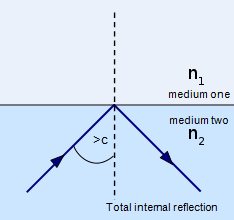Critical Angle
The total internal reflection of light occurs at the boundary between two different mediums. In order for 100% of the light that enters a medium to be reflected internally, two conditions must be met:
- The outside material must have a lower refractive index.
- The angle that the light strikes the boundary with must be greater than or equal to a specific value, which is unique to that medium. This specific value is called the critical angle.

As mentioned elsewhere, the equation for the critical angle of a medium is:
sinC=n1⁄n2
Where C is the critical angle in degrees, n1 is the refractive index of the outside material, and n2 is the refractive index of the material the light is travelling through.
Uses of Total Internal Reflection
Optical fibres are a textbook example of Total Internal Reflection being used in real life. They allow information to be transmitted very long distances, without any interference, at a very high speed.

Light is shone through one end of the fibre, which reflects internally, until it is received at the other end. The pattern of light pulses are used to represent binary 1's and 0's.